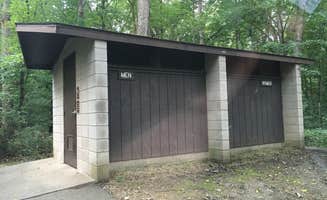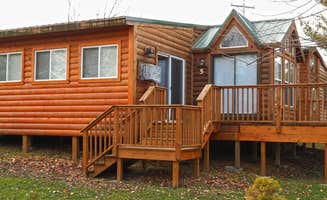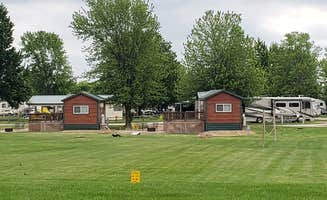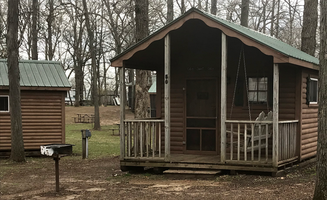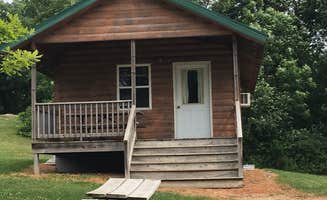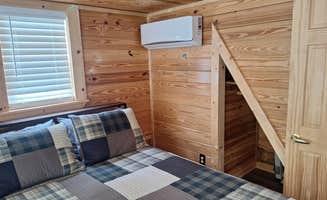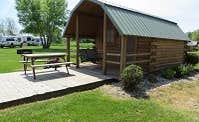Lake Mills, Wisconsin sits on the northern edge of the Kettle Moraine region, characterized by unique glacial landforms formed during the last ice age. The area features numerous kettle lakes, moraines, and eskers within a 25-mile radius. Summer temperatures average 75-85°F during peak camping season, with nighttime lows dropping to the 50s even in July, making it ideal for yurt camping and other glamping options.
What to do
Hiking the Ice Age Trail: Access trailheads within Kettle Moraine State Forest where you can explore ancient glacial formations. "Beautiful campground (Ottawa Lake campsites) Great Lake, hiking to see the natural springs which is the coolest!! Drank fresh spring water!" wrote a visitor to Ottawa Lake Campground — Kettle Moraine State Forest-Southern Unit.
Paddling and water activities: Many campgrounds offer direct lake access for kayaking and canoeing, especially on weekdays when water traffic is lighter. "Beautiful sites super quiet," noted a camper at Lake Kegonsa State Park Campground, which features both swimming beaches and boat launches.
Winter cross-country skiing: Several yurt camping locations near Lake Mills maintain groomed ski trails during winter months. "No showers in winter but awesome," reported one winter visitor at Ottawa Lake Campground, which stays open year-round for cold-weather camping enthusiasts.
Seasonal camping events: Many Lake Mills area campgrounds host themed weekends throughout the season. At Milton-Madison SE KOA, "There are 2 playgrounds, a nice pool, games and activities for the kids over weekends, and the rv sites are well spaced."
What campers like
Quiet weekday camping: Less crowded conditions Monday through Thursday mean better site selection and more peaceful experiences. A Lake Kegonsa visitor observed, "Beautiful sites super quiet," highlighting the tranquility available outside peak weekend periods.
Clean facilities: Well-maintained bathrooms and shower buildings receive consistent praise from campers in the Lake Mills region. At Snug Harbor Inn Campground on Turtle Lake, visitors appreciate that "There is a very clean bathroom and bathhouse, freshwater for campers, and some electric tent campsites."
Natural springs: Several camping areas feature natural springs you can visit and sometimes drink from. "Hiking to see the natural springs which is the coolest!! Drank fresh spring water!" wrote an excited Ottawa Lake camper.
Yurt accessibility: Yurt camping near Lake Mills offers premium comfort with many locations providing electricity inside structures. "We were able to grab a nonelectric site and transfer to an electric site when one cancelled last minute," noted a visitor at Ottawa Lake Campground, which offers various accommodation options.
What you should know
Insect preparation: Mosquitoes can be intense during summer months, especially near wetland areas. At Lake Kegonsa, one camper warned, "No bugs!" while others mentioned heavy mosquito presence during July and August.
Road noise: Some campgrounds near Lake Mills sit close to highways and traffic sounds may be noticeable. A visitor to Naga-Waukee Park observed, "The entire grounds is surrounded by roads, highways and the constant hum of traffic, sometimes louder than others."
Seasonal flooding: Spring and early summer can bring high water levels to certain campsites. "Half of camping sites closed due to flooding," noted one camper at Lakeland Camping Resort during a wet period.
Water testing: Some swimming areas post regular E. coli tests during hot summer weeks. One frequent visitor mentioned, "The lake is great for swimming, though they do have e coli warnings frequently in the heat of summer" at Ottawa Lake.
Tips for camping with families
Kid-friendly activities: Choose campgrounds with multiple play areas and scheduled activities. "Great place to bring our three boys. There are 2 playgrounds, a nice pool, games and activities for the kids over weekends," explained a parent who stayed at Milton-Madison SE KOA.
Yurt camping for beginners: For families new to camping near Lake Mills, yurts offer a comfortable introduction without the setup challenges of traditional tents. "We stayed in a rustic cabin with air-conditioning which made for great sleeping" reported a visitor to Yogi Bear's Jellystone Park at Fort Atkinson.
Campground navigation: Larger properties can require significant walking between facilities. At Lake Kegonsa State Park, a camper noted: "Campgrounds are split up between regular and group camping. The group camping site was down the road from regular camping."
Wildlife viewing opportunities: Early morning walks yield the best animal sightings. At Pilgrim's Campground, one visitor observed "amazing animals coming to graze throughout the day (and night) from deer, raccoons, opossums and endless tag teams of squirrels."
Tips from RVers
Site selection strategy: Reserve back-in sites along meadows or woods for better views and privacy. At Milton-Madison SE KOA, an RVer shared, "We had a back in spot right up to a field. Very pretty and peaceful."
Electric reliability: Check amperage requirements before booking, as some older campgrounds have inconsistent power delivery. "The sites were of decent size, some smaller than others and some very generous sites. I would recommend viewing their map and comparing to google maps," advised a KOA visitor.
Navigating tight campground roads: Larger rigs should scout routes before attempting certain loops or bridges. "There is also a low hanging overpass and it took the roofs off TWO fifth wheels while we were staying there," warned a Lake Kegonsa visitor about an unmarked low clearance area.
Dump station timing: Plan for wait times during peak checkout periods at popular campgrounds. One camper mentioned, "Upon leaving, we were in line at the dump station for about 40 minutes which was frustrating, and the road up to the dump station did not allow for cross traffic."


